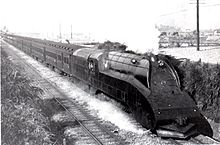Tsubame(train)
 800 Series ShinkansenTsubameat Shin-Minamata Station in November 2004 | |
| Overview | |
|---|---|
| Service type | Shinkansen(Local) |
| Status | Operational |
| Locale | Kyushu Shinkansen |
| First service | 1 October 1930 (Limited express) 13 March 2004 (Shinkansen) |
| Current operator(s) | JR Kyushu |
| Former operator(s) | JNR |
| Route | |
| Termini | Hakata Kumamoto orKagoshima-Chūō |
| On-board services | |
| Class(es) | Ordinary class + Green class |
| Catering facilities | Trolley refreshment service |
| Technical | |
| Rolling stock | 800 series/N700-7000 series/N700-8000 series |
| Track gauge | 1,435 mm(4 ft8+1⁄2in) |
| Electrification | 25 kV AC, 60 Hz |
| Operating speed | 260 km/h (160 mph)[1] |
TheTsubame(つばめ)is a train service operated byKyushu Railway Company(JR Kyushu) on theKyushu Shinkansenin Japan since 2004.[1]
The wordtsubame(Yến)in Japanese means "swallow",and has been used on a succession oflimited expresstrains on theTokaidoandSanyo Main Linein Japan since 1930.[2]
History
[edit]Pre-war
[edit]
TheTsubamename (originally written as "Yến" ) was first used from 1 October 1930 for limited express services operating betweenTokyoandKobe,hauled byJNR Class C51andJNR Class C53steam locomotives. These services operated until 30 September 1943.[2]
Post-war
[edit]The name was revived (this time written as "つばめ" ) from 1 January 1950 for limited express services operating between Tokyo andOsaka,hauled byJNR Class C62steam andJNR Class EF58electric locomotives, and later by151 serieselectric multiple unit(EMU) trains. From 1 October 1964, following the opening of theTōkaidō Shinkansen,the name was reassigned to limited express trains operating betweenShin-OsakaandHakata.From 1 October 1965, services were extended to operate betweenNagoyaand Hakata, operated by481and583 seriesEMUs. These services continued until 9 March 1975 (when theSan'yō Shinkansenwas fully in operation).[2]
JR Kyushu
[edit]TheTsubamename was once again revived byJR Kyushufrom 15 July 1992 for limited express services operating on theKagoshima Main LinebetweenMojiko/Hakataand Nishi-Kagoshima (nowKagoshima-Chūō Station), operated using new787 seriesEMUs in 6-, 7-, or 11-car formations.[2][3] These services operated until 12 March 2004, the day before the newKyushu Shinkansenopened.
Relay Tsubame
[edit]
With the start of services on theKyushu ShinkansenbetweenShin-YatsushiroandKagoshima-Chūōfrom 13 March 2004, newRelay Tsubameservices commenced on theKagoshima Main LinebetweenHakataandShin-Yatsushirousing 787 series EMUs in 7-, 8-, and 11-car formations.[1]The operation of theRelay Tsubameservice was unique, as it was the only station in Japan where normal trains stopped at platforms adjacent to the shinkansen platforms. This was to facilitate transfer of passengers from shinkansen toRelay Tsubameand vice versa. Normally, shinkansen platforms are physically separated from normal train platforms with fare gates and may be at a different level (usually above the normal train platforms).
When the remainder of the Kyushu Shinkansen was opened on 12 March 2011, theTsubamebecame an all-stations service (similar to theKodamaon the Tokaido and Sanyo Shinkansen), operating primarily as shuttle services between Hakata andKumamoto.Services operate twice per hour in each direction during the morning and evening, and once per hour during the middle of the day. SomeTsubameservices also run to/from Kagoshima-Chūō.[4]
Rolling stock
[edit]Shinkansen train services are formed of eight-carN700 series(JR West N700-7000 series and JR Kyushu N700-8000 series) trains or six-car JR Kyushu800 seriestrains.
-
A JR Kyushu 800 series train set in January 2022
-
A JR West N700-7000 series trainset
-
A JR Kyushu N700-8000 series trainset
Formations
[edit]N700 series
[edit]Eight-carN700 seriesservices are formed as follows, with car 1 at the Kagoshima-Chūō (southern) end. Cars 1 to 3 are ordinary-class cars with 2+3 seating, and cars 4 to 8 are ordinary-class cars with 2+2 seating. Half of car 6 has "Green car" (first class) 2+2 seating. All cars are non-smoking since the smoking ban in March 2024.[5]
| Car No. | 1 | 2 | 3 | 4 | 5 | 6 | 7 | 8 | |
|---|---|---|---|---|---|---|---|---|---|
| Accommodation | Non-reserved | Non-reserved | Non-reserved | Reserved | Reserved | Reserved | Green | Reserved | Reserved |
On some train services, cars 4 and 5 are also non-reserved.[6]
-
N700-7000 series Green car interior
-
N700-7000 series standard-class reserved car interior
-
N700-7000 series standard-class non-reserved car interior
800 series
[edit]Six-car800 seriesservices are formed as follows, with car 1 at the Kagoshima-Chūō (southern) end. All accommodation is ordinary class with 2+2 seating. All cars are non-smoking.[6]
| Car No. | 1 | 2 | 3 | 4 | 5 | 6 |
|---|---|---|---|---|---|---|
| Accommodation | Non-reserved | Non-reserved | Non-reserved | Reserved | Reserved | Reserved |
On some train services, car 4 is also non-reserved.[6]
-
Interior of an 800 series car
References
[edit]- ^abcJR tân càn tuyến & đặc cấp liệt xa ファイル[JR Shinkansen & Limited Express Train File] (in Japanese). Japan: Kōtsū Shimbun. August 2008. pp. 14–15.ISBN978-4-330-00608-6.
- ^abcdLiệt xa danh giam 1995[1995 Train Name Directory] (in Japanese). Japan: Railway Journal. August 1995.
- ^こだわりの tân càn tuyến & đặc cấp liệt xa ガイド[In-depth Shinkansen & Limited Express Train Guide] (in Japanese). Japan: Ikaros Publishing. July 2000. pp. 166–169.ISBN4-87149-284-2.
- ^Bình thành 23 niên xuân ダイヤ cải chính[Spring 2011 timetable revision] (Press release) (in Japanese). JR Kyushu. 17 December 2010. Archived fromthe originalon 20 December 2010.Retrieved19 December2010.
- ^"Smokers bitter as cigarettes banned on all Shinkansen lines | The Asahi Shimbun: Breaking News, Japan News and Analysis".The Asahi Shimbun.Retrieved17 May2024.
- ^abcJR Timetable.Japan: Kotsu Shimbunsha. February 2015. p. 951.EAN4910053110259.













